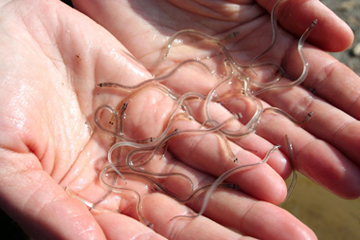Juvenile glass eels aren’t the most appetizing critters around. They look like short, wiggly transparent noodles, and it takes thousands of them to fill a bucket. And then there’s their other name — elvers. Yet in recent years these tiny creatures have become some of the most expensive fish in American waters, fetching up to $2,000 a pound — and spawning a big increase in poaching.
 Eels are a popular staple of Asian sushi markets. But the Japanese tsunami and other factors reduced Asian stocks, and Europe has cut back on exports. That left American eels, which can be legally harvested in Maine and South Carolina. Aquaculture operations in Asia buy the juvenile eels and raise them until they’re big enough to sell to restaurants and markets.
Eels are a popular staple of Asian sushi markets. But the Japanese tsunami and other factors reduced Asian stocks, and Europe has cut back on exports. That left American eels, which can be legally harvested in Maine and South Carolina. Aquaculture operations in Asia buy the juvenile eels and raise them until they’re big enough to sell to restaurants and markets.
Adult eels spawn in the Sargasso Sea. After the eggs hatch, the larvae drift with the currents until they reach the East Coast, where they settle in rivers and streams.
But the increased demand is putting extra pressure on the little guys. The elver population was already dwindling as the result of overfishing, loss of habitat, environmental changes, and other factors. In fact, population levels appear to be at all-time lows, and the species may be approaching endangered status. The economic incentive for fishing — both legal and illegal — is just making things worse.
Both state and federal agencies have been looking at ways to reduce elver fishing. Their efforts may be needed to help save the dwindling stocks of these wiggly but popular little fish.

